Bitcoin mining is done by specialized computers.
The role of miners is to secure the network and to process every Bitcoin transaction.
Miners achieve this by solving a computational problem which allows them to chain together blocks of transactions (hence Bitcoin’s famous “blockchain”).
For this service, miners are rewarded with newly-created Bitcoins and transaction fees.
What is Bitcoin Mining Actually Doing?
What is the point of Bitcoin mining? This is something we're asked everyday!
There are many aspects and functions of Bitcoin mining and we'll go over them here. They are:
- Issuance of new bitcoins
- Confirming transactions
- Security
Mining Is Used to Issue new Bitcoins

Traditional currencies--like the dollar or euro--are issued by central banks. The central bank can issue new units of money ay anytime based on what they think will improve the economy.
Bitcoin is different.
With Bitcoin, miners are rewarded new bitcoins every 10 minutes.
The issuance rate is set in the code, so miners cannot cheat the system or create bitcoins out of thin air. They have to use their computing power to generate the new bitcoins.
Miners Confirm Transactions

Miners include transactions sent on the Bitcoin network in their blocks.
A transaction can only be considered secure and complete once it is included in a block.
Why?
Because only a when a transaction has been included in a block is it officially embedded into Bitcoin's blockchain.
More confirmations are better for larger payments. Here is a visual so you have a better idea:
0
Payments with 0 confirmations can still be reversed! Wait for at least one.
1
One confirmation is enough for small Bitcoin payments less than $1,000.
3
Enough for payments $1,000 - $10,000. Most exchanges require 3 confirmations for deposits.
6
Enough for large payments between $10,000 - $1,000,000. Six is standard for most transactions to be considered secure.
Miners Secure the Network

Miners secure the Bitcoin network by making it difficult to attack, alter or stop.
The more miners that mine, the more the secure the network.
The only way to reverse Bitcoin transactions is to have more than 51% of the network hash power. Distributed hash power spread among many different miners keeps Bitcoin secure
To be real:
Most people should NOT mine bitcoins today.
Most Bitcoin mining is specialized and the warehouses look something like this:
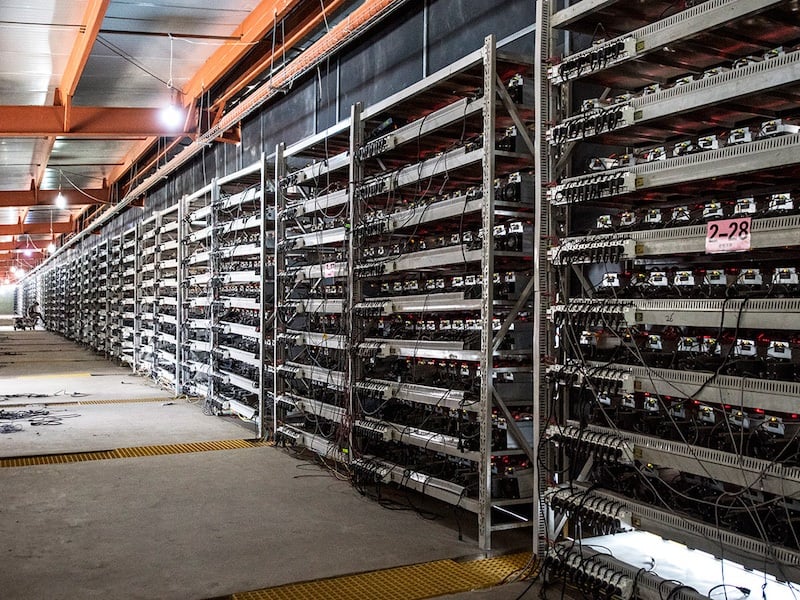
That's who you're up against! It’s simply too expensive and you are unlikely to turn a profit.
However:
For hobby mining, we’ll show you some steps you can take to get started mining bitcoins right now.
Step #1: Get Bitcoin Wallet
When earning bitcoins from mining, they go directly into a Bitcoin wallet.
You can't mine without a wallet.
Our guide on the best bitcoin wallets will help you select a wallet.
Step #2: Find a Bitcoin Exchange
When earning bitcoins from mining, you may need to sell the coins to pay for power costs. You may also need to buy coins on exchanges.
Step #3: Get Bitcoin Mining Hardware
You won’t be able to mine without an ASIC miner.
ASIC miners are specialized computers that were built for the sole purpose of mining bitcoins.
Don’t even try mining bitcoins on your home desktop or laptop computer! You will earn less than one penny per year and will waste money on electricity.
This video from 2017 shows how difficult it is to make money mining using GPUs, and this was in 2017. It is far less profitable today than it was in 2017.
Step #4: Select a Mining Pool
Once you get your mining hardware, you need to select a mining pool.
Without a mining pool, you would only receive a mining payout if you found a block on your own. This is called solo mining.
We don’t recommend this because your hardware’s hash rate is very unlikely to be anywhere near enough to find a block solo mining.
How do mining pools help?
By joining a mining pool you share your hash rate with the pool. Once the pool finds a block you get a payout based on the percent of hash rate contributed to the pool.
If you contributed 1% of the pools hashrate, you’d get .125 bitcoins out of the current 12.5 bitcoin block reward.
Step #5: Get Bitcoin Mining Software
Bitcoin mining software is how you actually hook your mining hardware into your desired mining pool.
You need to use the software to point your hash rate at the pool.
Also in the software you tell the pool which Bitcoin address payouts should be sent to.
If you don’t have a Bitcoin wallet or address learn how to get one here.
There is mining software available for Mac, Windows, and Linux.
Step #6: Is Bitcoin Mining Legal in your Country? Make Sure!
This won’t be much of an issue in MOST countries.
Consult local counsel for further assistance in determining whether Bitcoin mining is legal and the tax implications of doing the activity.
Like other business, you can usually write off your expenses that made your operation profitable, like electricity and hardware costs.
Step #7: Is Bitcoin Mining Profitable for You?

Do you understand what you need to do to start?
You should run some calculations and see if Bitcoin mining will actually be profitable for you.
You can use a Bitcoin mining calculator to get a rough idea.
I say rough idea because many factors related to your mining profitability are constantly changing.
A doubling in the Bitcoin price could increase your profits by two.
But:
It could also make mining that much more competitive that your profits remain the same.
How to Mine Bitcoins on Android or iOS

Here’s what’s funny:
You actually CAN mine bitcoins on any Android device.
Using mining software for Android you can mine bitcoins or any other coin.
What’s not so fun?
You’ll likely make less than one penny PER YEAR!
Why?
Android phones simply are not powerful enough to match the mining hardware used by serious operations.
So, it might be cool to setup a miner on your Android phone to see how it works. But don’t expect to make any money.
Do expect to waste a lot of your phone’s battery!
When Satoshi released Bitcoin, he intended it to be mined on computer CPUs.
However:
Enterprising coders soon discovered they could get more hashing power from graphic cards and wrote mining software to allow this.
GPUs were surpassed in turn by ASICs (Application Specific Integrated Circuits).
Nowadays all serious Bitcoin mining is performed on ASICs, usually in thermally-regulated data-centers with access to low-cost electricity.
Economies of scale have thus led to the concentration of mining power into fewer hands than originally intended.
As with GPU and ASIC mining, Satoshi apparently failed to anticipate the emergence of mining pools.
Pools are groups of cooperating miners who agree to share block rewards in proportion to their contributed mining power.
This pie chart displays the current distribution of total mining power by pools:
While pools are desirable to the average miner as they smooth out rewards and make them more predictable, they unfortunately concentrate power to the mining pool’s owner.
What does a mining farm look like?
Let's take a look inside a real Bitcoin mining farm in Washington state.
Bitcoin mining farms exclusively use ASIC miners to mine various coins. Many of these farms are minting several Bitcoins per day.
How much do crypto mining farms make?
How much a mining farm makes depends on many factors:
- The price it pays for electricity
- How old its mining hardware is
- The scale of its operation
- The price of Bitcoin when the miner sells it
- The level of difficulty when the Bitcoin is mined
By far, the biggest factor affecting how much money a mining farm makes is how much it pays for electricity. Nearly all mining farms are using the same hardware.
Since the reward for finding a block is fixed, and the difficulty is adjusted based on total processing power working on finding blocks at any given time, then electricity is the only cost that is variable. If you can find cheaper power than other miners, you can afford to either increase the size of your mining operation, or spend less on your mining for the same output.
How much electricity do mining farms use
As previously mentioned, mining farms use a lot of electricity. How much they consume depends on how big their operation is. However the latest Bitmain ASIC miner consumes about 1350 watts.
In total, it is estimated that all mining farms will use about 75 terrwat hours of electricity in the year 2020. That is roughly the equivalent to 15 times the yearly energy consumption of denmark.
Where are mining farms located?

Mining farms are located all over the world. We don't know where every mining farm in the world is, but we have some educated guesses.
Most of the mining has been and still is located in China. In fact, as of 2020, it is believed that as much as 65% of Bitcoin mining occurs in China.
Why is so much Mining happening in China? Samson Mow of Blockstream and former CTO of BTCC mining pool explains.
The main advantages of mining in China are faster setup times and lower initial CapEx which, along with closer proximity to where ASICs are assembled, have driven industry growth there
 Samson Mow CSO, Blockstream
Samson Mow CSO, BlockstreamWhere do mining farms get all their graphics cards?
Nowhere! Mining farms do not use Graphics cards (GPUs) to do any mining because it is not profitable or scalable to do so. Bitcoin mining farms exclusively use ASIC miners which are many hundreds of thousands of times more efficient at mining Bitcoin than GPUs.
Miner
Anyone who mines Bitcoins (or any other cryptocurrency).
Block Reward
The block reward is a fixed amount of Bitcoins that get rewarded to the miner or mining pool that finds a given block.
Mining Pool
A collection of individual miners who 'pool' their efforts or hashing power together and share the blockreward. Miners create pools because it increases their chances of earning a block reward.
learn more about mining pools.
Block Reward Halving

Approximately every 4 years, the block reward gets cut in half. The first block reward ever mined was in 2008 and it it was for 50 Bitcoins. That block reward lasted for four years, where in 2012, the first reward halving occured and it dropped to 25 Bitcoins.
In 2016, a second halving occured where the reward was reduced to 12.5 Bitcoins. And as of the time of this writing, we are on the cusp of the third halving (ETA May 11th), where the reward will be cut down to 6.25 Bitcoins. You can find the most up to date estimation of exactly when the next halving will occur on our bitcoin block reward halving clock.
ASIC Miner

ASIC stand for "Application Specific Integrated Circuit". In plain english, that just means it is a cheap designed to do one very specific kind of calculation. In the case of of an ASIC miner, the chip in the miner is designed to solve problems using the SHA256 hashing algorithm. This is opposed to GPU mining, explained below.
Learn more about ASIC Miners
GPU Mining

GPU mining is when you mine for Bitcoins (or any cryptocurrency) using a graphics card. This was one of the earliest forms of mining, but is no longer profitable due to the introduction of ASIC miners.
Hashing Power (or Hash Rate)
How many calculations (hashes) a miner can perform per second.
Or it can refer to the total amount of hashing done on a chain by all miners put together - also known as "Net Hash".
You can learn more about Hash Rate by reading our article about it.
Difficulty
Measured in Trillions, mining difficulty refers to how hard it is to find a block. The current level of difficulty on the Bitcoin blockchain is the primary reason why it is not profitable to mine for most people.
Difficulty Adjustment

Bitcoin was designed to produce block reliably every 10 mintues. Because total hashing power (or Net Hash) is constantly changing, the difficulty of finding a block needs to adjust proportional to the amount of total hashing power on the network.
In very simple terms, if you have four miners on the network, all with equal hashing power, and two stop mining, blocks would happen ever 20 mintues instead of every ten. Therefore, the difficulty of finding blocks also needs to cut in half, so that blocks can continue to be found every 10 minutes.
Difficulty adjustments happen every 2,016 blocks. This should mean that if a new block is added every 10 minutes, then a difficulty adjustment would occur every two weeks. The 10 minute block rule is just a goal though. Some blocks are added after more than 10 minutes. Some are added after less. Its a law of averages and a lot if left up to chance. That doesn't mean that for the most part, blocks are added reliably every 10 minutes.
Kilowatt Hour
A measurement of energy consumption per hour. Most ASIC miners will tell you how much energy they consume using this metric.
Isn’t Mining a Waste of Electricity?
Certain orthodox economists have criticized mining as wasteful.
It must be kept in mind however that this electricity is expended on useful work:
Enabling a monetary network worth billions (and potentially trillions) of dollars!
Compared to the carbon emissions from just the cars of PayPal’s employees as they commute to work, Bitcoin’s environmental impact is negligible.
As Bitcoin could easily replace PayPal, credit card companies, banks and the bureaucrats who regulate them all, it begs the question:
Isn’t traditional finance a waste?
Not just of electricity, but of money, time and human resources!
Mining Difficulty
If only 21 million Bitcoins will ever be created, why has the issuance of Bitcoin not accelerated with the rising power of mining hardware?
Issuance is regulated by Difficulty, an algorithm which adjusts the difficulty of the Proof of Work problem in accordance with how quickly blocks are solved within a certain timeframe (roughly every 2 weeks or 2016 blocks).
Difficulty rises and falls with deployed hashing power to keep the average time between blocks at around 10 minutes.
For most of Bitcoin's history, the average block time has been about 9.7 minutes. Because the price is always rising, mining power does come onto the network at a fast speed which creates faster blocks. However, for most of 2019 the block time has been around 10 minutes. This is because Bitcoin's price has remained steady for most of 2019.
Block Reward Halving
Satoshi designed Bitcoin such that the block reward, which miners automatically receive for solving a block, is halved every 210,000 blocks (or roughly 4 years).
As Bitcoin’s price has risen substantially (and is expected to keep rising over time), mining remains a profitable endeavor despite the falling block reward… at least for those miners on the bleeding edge of mining hardware with access to low-cost electricity.
Honest Miner Majority Secures the Network
To successfully attack the Bitcoin network by creating blocks with a falsified transaction record, a dishonest miner would require the majority of mining power so as to maintain the longest chain.
This is known as a 51% attack and it allows an attacker to spend the same coins multiple times and to blockade the transactions of other users at will.
To achieve it, an attacker needs to own mining hardware than all other honest miners.
This imposes a high monetary cost on any such attack.
At this stage of Bitcoin’s development, it’s likely that only major corporations or states would be able to meet this expense… although it’s unclear what net benefit, if any, such actors would gain from degrading or destroying Bitcoin.
Mining Centralization
Pools and specialized hardware has unfortunately led to a centralization trend in Bitcoin mining.
Bitcoin developer Greg Maxwell has stated that, to Bitcoin’s likely detriment, a handful of entities control the vast majority of hashing power.
It is also widely-known that at least 50% of mining hardware is located within China.
However, it’s may be argued that it’s contrary to the long-term economic interests of any miner to attempt such an attack.
The resultant fall in Bitcoin’s credibility would dramatically reduce its exchange rate, undermining the value of the miner’s hardware investment and their held coins.
As the community could then decide to reject the dishonest chain and revert to the last honest block, a 51% attack probably offers a poor risk-reward ratio to miners.
Bitcoin mining is certainly not perfect but possible improvements are always being suggested and considered.
How Does Bitcoin Mining Work?
This simplified illustration is helpful to explanation:
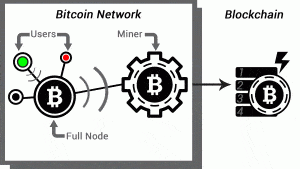
1) Spending
Let’s say the Green user wants to buy some goods from the Red user. Green sends 1 bitcoin to Red.

2) Announcement
Green’s wallet announces a 1 bitcoin payment to Red’s wallet. This information, known as transaction (and sometimes abbreviated as “ tx”) is broadcast to as many Full Nodes as connect with Green’s wallet – typically 8. A full node is a special, transaction-relaying wallet which maintains a current copy of the entire blockchain.
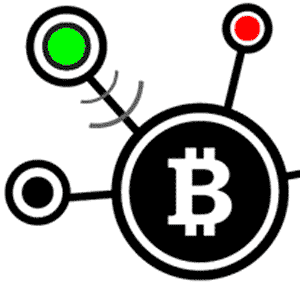
3) Propagation
Full Nodes then check Green’s spend against other pending transactions. If there are no conflicts (e.g. Green didn’t try to cheat by sending the exact same coins to Red and a third user), full nodes broadcast the transaction across the Bitcoin network. At this point, the transaction has not yet entered the Blockchain. Red would be taking a big risk by sending any goods to Green before the transaction is confirmed. So how do transactions get confirmed? This is where Miners enter the picture.
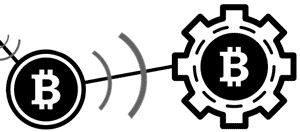
4) Processing by Miners
Miners, like full nodes, maintain a complete copy of the blockchain and monitor the network for newly-announced transactions. Green’s transaction may in fact reach a miner directly, without being relayed through a full node. In either case, a miner then performs work in an attempt to fit all new, valid transactions into the current block.
Miners race each other to complete the work, which is to “package” the current block so that it’s acceptable to the rest of the network. Acceptable blocks include a solution to a Proof of Work computational problem, known as ahash . The more computing power a miner controls, the higher their hashrate and the greater their odds of solving the current block.
But why do miners invest in expensive computing hardware and race each other to solve blocks? Because, as a reward for verifying and recording everyone’s transactions, miners receive a substantial Bitcoin reward for every solved block!
And what is a hash? Well, try entering all the characters in the above paragraph, from “But” to “block!” into this hashing utility. If you pasted correctly – as a string hash with no spaces after the exclamation mark – the SHA-256 algorithm used in Bitcoin should produce:
“6afc21238f2d33e24e168195888721dd5ace05d76196671d6739789af92201ed.”
If the characters are altered even slightly, the result won’t match. So, a hash is a way to verify any amount of data is accurate. To solve a block, miners modify non-transaction data in the current block such that their hash result begins with a certain number (according to the current Difficulty, covered below) of zeroes. If you manually modify the string until you get a 0… result, you’ll soon see why this is considered “Proof of Work!”
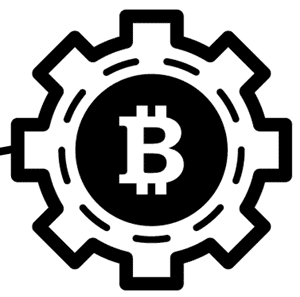
5) Blockchain Confirmation
The first miner to solve the block containing Green’s payment to Red announces the newly-solved block to the network. If other full nodes agree the block is valid, the new block is added to the blockchain and the entire process begins afresh. Once recorded in the blockchain, Green’s payment goes from pending to confirmed status.
Red may now consider sending the goods to Green. However, the more new blocks are layered atop the one containing Green’s payment, the harder to reverse that transaction becomes. For significant sums of money, it’s recommended to wait for at least 6 confirmations. Given new blocks are produced on average every ten minutes; the wait shouldn’t take much longer than an hour.
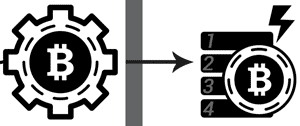
The Longest Valid Chain
You may have heard that Bitcoin transactions are irreversible, so why is it advised to await several confirmations? The answer is somewhat complex and requires a solid understanding of the above mining process:
Let’s imagine two miners, A in China and B in Iceland, who solve the current block at roughly the same time. A’s block (A1) propagates through the internet from Beijing, reaching nodes in the East. B’s block (B1) is first to reach nodes in the West. There are now two competing versions of the blockchain!
Which blockchain prevails? Quite simply, the longest valid chain becomes the official version of events. So, let’s say the next miner to solve a block adds it to B’s chain, creating B2. If B2 propagates across the entire network before A2 is found, then B’s chain is the clear winner. A loses his mining reward and fees, which only exist on the invalidated A -chain.
Going back to the example of Green’s payment to Red, let’s say this transaction was included by A but rejected by B, who demands a higher fee than was included by Green. If B’s chain wins then Green’s transaction won’t appear in the B chain – it will be as if the funds never left Green’s wallet.
Although such blockchain splits are rare, they’re a credible risk. The more confirmations have passed, the safer a transaction is considered.
A Complete Analysis on the Electricity Use of Bitcoin & Why It's not a Waste
In March 2016, Motherboard projected this:
Bitcoin’s electricity consumption will grow to rival that of the nation of Denmark by 2020.
Whatever the accuracy of Motherboard’s math, there’s no disputing the fact that Bitcoin uses a great deal of energy.
On an industrial level, Bitcoin may be considered a system which converts electricity directly into money.
There are two major camps which object to Bitcoin mining due to its electrical cost:
1) The Eco-conscious

The eco-conscious seek to generally diminish global power consumption.
Given that electricity is, at present, primarily generated through unsustainable methods, eco-activists hold that all energy expenditures must be critically weighed against their (debatable) contribution to climate change.
2) Skeptical Economists
Secondly, there are those dubious economists who doubt Bitcoin’s viability.

This group is best exemplified by Paul Krugman, who argues that Bitcoin (and to a lesser extent, gold) has no real value to society and so represents a waste of resources and labour.
Defending Bitcoin’s Power Usage
While disproving the “economic experts” is as simple as referring them to Bitcoin’s current market price and continued existence, explaining why Bitcoin is worth its electrical cost to the eco-conscious requires a more thoughtful approach.
After all, social pressure to sustainably power the Bitcoin project is sensible. We need to maintain a healthy balance between nature and technology.
That said, until advances in green energy diminish or negate Bitcoin’s draw on ecologically-costly energy sources, Bitcoiners must endeavor to defend the expenditure by conveying the importance of this revolutionary peer-to-peer currency!
Here are 9 good reasons which, taken together and in our opinion, completely justify the world’s admittedly high expenditure of electricity on the Bitcoin project:
1) Bitcoin is Backed by Electricity (and Ingenuity)
You mean there isn’t an ounce of gold in the bank for every paper Dollar?
Over the millennia, history has repeatedly shown that prosperity depends on sound money. Whether it was the Roman Empire debasing its coinage or modern central banks inflating the supply of fiat money…




0 Comments